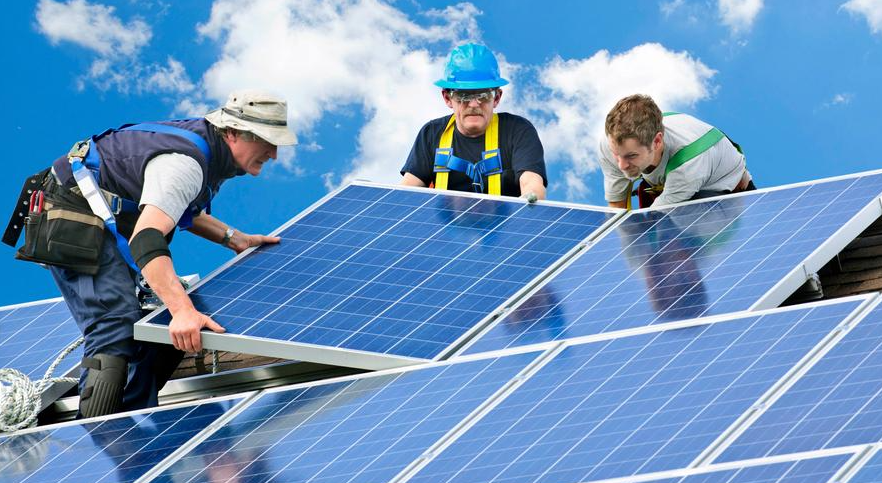What Is Involved in the Solar Panel Installation Process?
The process of solar panel installation is fast and easy. Solar panels are the top choice for
being eco-friendly in an era when you;re encouraged to “go green’
Made up of photo voltaic cells and electrical input, the panels will help you generate and
store electricity for your household.
But what is involved in the solar panel installation process?
Please look at our guide to everything you need to know about solar panels, from what they
do to how you get them.
Assessment of the Size of the Area
The process of installing solar panels involves an assessment of the area chosen to install
the system. A certified technician will assess the size of the site to determine the number of
panels and the size of the inverters needed to meet the needs of a particular property.
Estimate the Load Size That the Property Is Expecting To Use
This step requires considering how much electricity the property will consume when
installed. It can be checked by looking at the electricity bills for the last few years. It takes
into account both the usage and the peak demand.
There are also some things to consider when estimating the load size of the property. Things
Like:
Positioning of the Property
It is also necessary to consider the positioning of the property. The amount of sunlight
available determines the optimal positioning of solar panels.
Determine the Size of the Solar Panel
To estimate the load size of the property, you should determine the size of the solar panel
system. After considering the propertys positioning and electricity usage, you can select the
solar panel system size to meet the property’s energy requirements.
Evaluate the Possible Obstructions
The process should ideally begin with a site survey to check the possible obstructions that
affect the solar equipment. It could include blocks due to vegetation, orientation, and
surrounding feature. A structural engineer should review the area to ensure it is suitable for
installation to be able to choose the best possible site.
Consult Any Existing Wiring and Location Restrictions
The consultation of any existing wiring and location restrictions is also a vital part of the
process. Before buying and installing solar panels, it is crucial to check with an electrician
and learn any local laws or regulations connected to the installation in the desired space.
Additionally, it reviews existing wiring to ensure the necessary adjustments or repairs before
the installation. To keep wiring up to code and reduce the likelihood of equipment damage.
Finally, assess the physical space of the installation to ensure safety and structural
soundness and the availability of natural sunlight. The completion of all these tasks allows
for a smoother installation process.
Understanding Electrical Requirements and Safety Precautions
The installer must know the electrical requirements when assembling and affixing the solar
panel system. Such as output voltage, power output, and how to properly ground the design.
The certified electrician must ensure all connections are tight, grounded, and secured. Take
precautions when exposing resistive elements to wet areas.
It is imperative to follow safety standards and place exposed wires in the conduit for
protection. The final step is to connect the solar array to the utility meter, allowing solar-
generated electricity to flow to the grid.
Calculate the Energy Needs and Cost
There is a need for calculations of the energy needs and the cost. The solar system needs to
face the correct direction. And be on a suitable surface to ensure the system can produce
the energy required.
To decide the price to install,s through the size and type of system you need. Also, the
materials and labor necessary to install the system and any upgrades or modifications to
your building. After installing the system, the cost savings will become evident through the
cutback in your electricity bills and clean, renewable solar energy production.
Step-by-Step Guide to Installing Solar Panels
Installing solar panels is a procedure that many people like to do by themselves or hire a
professional to do for them. The first step is to decide how many panels are needed based
on the size of the roof and the amount of electricity desired.
After buying the panels, the next step is to consider local codes and permits for home solar
power projects. It can involve getting an electrical inspection and any other registration
requirements in the area.
After accounting for it, the actual installation of the panels can begin. It can involve securing
the rails, mounting the panels, and then wiring them together.
To finish the installation, you must access inverters, batteries, and other components.
Finally, the system must be flipped on and tested after connecting all parts to ensure it is
functioning appropriately.
Taking these steps can result in a fully functioning solar panel field, saving money on
electricity. You can visit here to get help from a solar company to install solar panels.
Different Types of Solar Panel Mounts
Roof mounting requires pre-measuring roof lines and following the local building code
requirements. Pole mounting requires digging and securing, and leveling the pole.
The ground mount requires digging holes, setting posts, and leveling the support. Flat roof
mounting requires adding flashing and making an aluminum frame to seal out water.
Prepare for the Solar Panel Installation Process
The solar panel installation process is a complex venture that you can simplify with the help
of a solar panel service provider. If you are considering installing solar panels at your home
for business, contact a professional today to access the benefits of clean, renewable energy!
Solar panel installation is one of many things we can help you with around your home.
Check out our blog for more home improvement tips.

